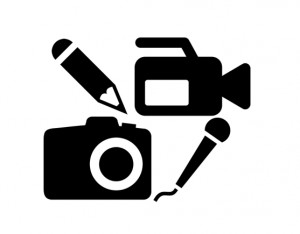Visual storytelling and moving beyond ‘multimedia’: Part 1
 Multimedia. It’s a term that’s part of the global language of media and journalism and yet, why do we find it problematic to use or define?
Multimedia. It’s a term that’s part of the global language of media and journalism and yet, why do we find it problematic to use or define?
We apply the word “multimedia” in many different ways – from describing types of stories to job titles to categories of awards to sections of websites to journalism courses and workshops, and yes, even the category of this blog post.
A common starting point for discussing “multimedia” is usually something to do with stories using a combination of photography, audio, video, text and graphics.
But is that precise? Is a book with text and pictures “multimedia”? Why is a video story frequently considered to be “multimedia”? And, if we present our audience with the same story but in different versions – audio, video, or text and photos – is that also “multimedia”?
In a blog post entitled I Hate Multimedia, MediaStorm’s Eric Maierson recently summed things up by saying “multimedia” can mean anything, it just depends on whom you ask.
‘The real issue is that “multimedia” is too small. It distracts and limits the possibilities we should be embracing.’
But while “what is multimedia?” is an ongoing and contentious debate, there is a sense that media professionals want to move forward. Especially at a time when technology, such as smartphones, tablets and social media, offer new storytelling and distribution possibilities and place even more pressure on the business models of older media, and media professionals who are struggling to adapt.
So, where to next for “multimedia”?
Where disciplines intersect – the concept of “visual storytelling”
Dr David Campbell’s recently published study “Visual Storytelling in the Age of Post Industrialist Journalism” is essential reading to understand the current state of “multimedia”.
There are six videos that accompany the study featuring interviews with a range of experts including Brian Storm (MediaStorm), Grant Scott (Hungry Eye), Marguerite Howell (The Economist), Bjarke Myrthu (Storyplanet) among others. All well worth watching.
In the introduction video below, Campbell says the aim of the research was “to take the pulse” of what’s happening globally in this field and to start a conversation about “multimedia”.
An Introduction to the Multimedia Research Project from World Press Photo on Vimeo.
Although the study is examining “multimedia”, when it comes to working out a definition, Campbell questions whether seeking “any single definition” is productive:
“Multimedia cannot and should not be defined as single genre. It involves a combination of images, sound, graphics, and text to generate a story, and it appears in multiple forms from online photo galleries where pictures are combined with text captions, to audio slideshows, linear video (both short-form and long form), animated infographics, non-linear interactives, and full-scale web documentaries and broadcast films.”
Instead, Campbell sets out the argument that there is a new media space where various disciplines gather around the concept of “visual storytelling” and share a common purpose in image-orientated reportage. Importantly he describes an intersection of disciplines, not the creation of a new visual genre. As he writes:
“Photojournalism, videojournalism, documentary film, cinema and interactive storytelling intersect, not to create a new visual genre, but to combine their respective strengths in image-orientated reportage, in many forms and across multiple platforms.”
 Campbell’s study was conducted under the auspices of the World Press Photo Academy and FotoFederatie, so yes it does lean towards approaching visual storytelling from a photojournalism perspective. But this by no means a drawback.
Campbell’s study was conducted under the auspices of the World Press Photo Academy and FotoFederatie, so yes it does lean towards approaching visual storytelling from a photojournalism perspective. But this by no means a drawback.
Along with a downloadable PDF of the research paper Campbell offers more follow up posts on his website.
In Part 2 of Visual storytelling and moving beyond ‘multimedia’, we’ll talk to Dr David Campbell about his research and trends in visual storytelling.
Author: Guy Degen




Feedback